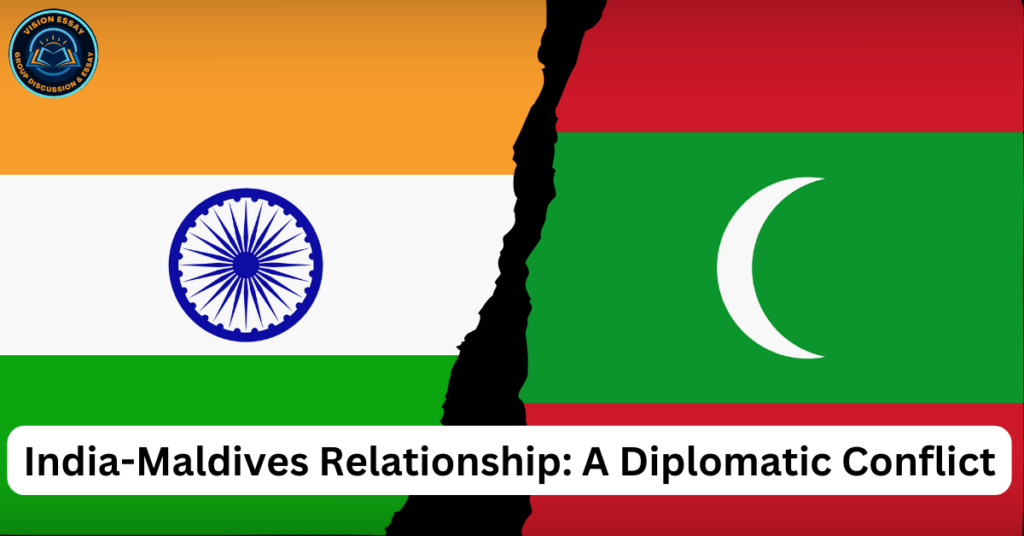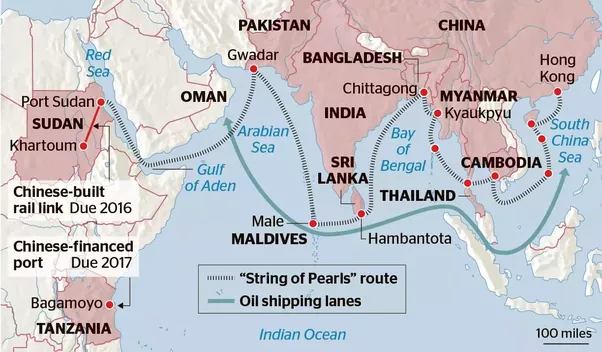
Introduction
The controversy surrounding Indian Prime Minister Narendra Modi’s visit to Lakshadweep further strained the already strained India-Maldives Relationship. The issue started when three Maldivian deputy ministers in the Ministry of Youth Affairs made disparaging remarks against India and the Prime Minister during his most recent visit to Lakshadweep.
Why the India-Maldives Relationship is Important?
Strategic Significance:
- Focal Point of India’s Neighbourhood First Policy
- The Maldives have great strategic significance for India due to its proximity to the country’s west coast and its location at the intersection of major commercial maritime lanes that traverse the Indian Ocean.
- India as a First Responder to the Maldives
- The establishment of trust and long-lasting, amicable bilateral ties between India and the Maldives was made possible by India’s prompt reaction and help during the 1988 coup attempt. Operation Cactus was swiftly carried out by the Indian Armed Forces.
- India was the first to respond to the Maldives amid the water crisis in Malé in December 2014 and the tsunami that struck in 2004.
- India furthered its reputation as the “first responder” when it sent 30,000 doses of the measles vaccine to the Maldives in January 2020 to stop an epidemic. India also provided the Maldives with prompt, all-encompassing help during the Covid-19 pandemic.
- India as a Net Security Provider
- It is widely acknowledged that India plays a crucial strategic role in the Maldives and is regarded as a Net Security Provider.
- To strengthen the defense collaboration, a detailed Action Plan for Defense was agreed in April 2016.
- The Security and Growth for All in the Region (SAGAR) initiative, spearheaded by India, benefits from both countries’ crucial roles in preserving the safety and security of the Indian Ocean Region (IOR).
- Joint Exercises “Ekuverin,” “Dosti,” “Ekatha,” and “Operation Shield” are among the areas in which defense cooperation is practiced.
Economic and Trade Engagements:
- Tourism Economy
- The Maldives, whose economy is mostly reliant on tourism, receives a significant portion of its tourists from India.
- With a roughly 11.8% market share in 2023, India topped the list of countries sending the most visitors to the Maldives (2,09,198).
- Trade Agreements
- In 2022, India ranked as the Maldives’ second-biggest trading partner. In 2021, the value of bilateral commerce surpassed USD 300 million for the first time.
- The Maldives Monetary Authority and the RBI inked a bilateral USD currency swap agreement on July 22, 2019.
- India’s main exports to the Maldives include a range of engineering and industrial goods, including medicines, cement, and agricultural products, while its main imports from the country are scrap metals.
Development and Capacity Buiding:
- Infrastructure Projects
- The Greater Male Connectivity Project (GMCP), the largest infrastructure project in the Maldives, was contracted in August 2021 by Afcons, an Indian firm.
- With the help of an Indian credit line, the Hanimaadhoo International Airport Development project would build a brand-new terminal that can accommodate 1.3 million travelers annually.
- India’s Minister of External Affairs dedicated the National College for Policing and Law Enforcement (NCPLE) in 2022.
- Healthcare Sector
- In the field of healthcare, India has contributed Rs 52 crore towards the establishment of Indira Gandhi Memorial Hospital in addition to aiding in the establishment of a cutting-edge cancer center that would link more than 150 medical facilities across many islands.
- Educational Programmes
- India contributed to the establishment of a technical education institute in 1996. In a USD 5.3 million initiative, India has also launched a training program for Maldivian youth and teachers, as well as vocational training.
- Around 70% of the Maldivian National Defence Force’s (MNDF) training needs are met by India, which offers the most training possibilities.
Cultural Connectivity:
- India and the Maldives have long-standing ties in terms of ethnicity, language, culture, and religion. According to anthropologists, the origins of Dhivehi (the Maldivian language) go back to Sanskrit and Pali.
- The estimated number of Indian expatriates in the Maldives is 27,000. Indian nationals make up the bulk of the foreign educators working in the Maldives.
Also read: India Maldives Relations 2023
What are the Main Concerns in the India- Maldives Relationship?
- The Ongoing Lakshadweep Issue
- Following the Prime Minister’s recent visit to Lakshadweep, three Maldivian deputy ministers made disparaging remarks against India and the Prime Minister, sparking a controversy.
- Claiming that the visit by the Indian Prime Minister was designed to undermine Maldivian tourism—which is famed for its luxurious beachfront accommodations—they denounced the visit.
- The Maldives government suspended the ministers after the Indian government brought up the matter with them.
- Numerous Indian travelers have canceled their Maldives vacation plans as a result of this dispute. The episode illustrates the perils of hypernationalism in the area.
- The possible effects of this incident would “concern” the Maldives tourism sector.
- The India Out Campaign In Maldives
- By sowing doubt about India’s investments in the Maldives, the defense alliances between the two countries, and India’s security commitments in the area, the ‘India Out’ campaign aims to increase hostility.
- The recent election of the Maldivian government is strongly against the ‘India First’ strategy of the previous administration; in fact, one of Muizzu’s election program items was the evacuation of Indian soldiers.
- Sovereignty and Security Dilemma
- The Maldives’ democracy is still in its infancy and is battling socio-political instability in the area that is influenced by powerful international entities.
- The Maldivian opposition is adamant that the national security and sovereignty of the nation are threatened by India’s military deployment there.
- On the other hand, the administration has repeatedly underlined that the India Out movement endangers the nation’s security. It is seen to be an issue that might irritate the partner nation that offers the island nation benefits related to regional security.
- Revocation of Hydrographic Survey Agreement
- It is important to remember that hydrographic data is intrinsically dual, with the ability to be utilized for both military and civilian objectives.
- Maldives is concerned that India’s hydrographic activities may be used for intelligence gathering.
- Indian strategic circles are concerned by the Maldives’ recent decision to withdraw their agreement with India for cooperative hydrographic studies in their seas.
- The China Factor in the Indian Ocean Region
- A significant “pearl” in China’s “String of Pearls” metaphor for South Asia is now the Maldives.
- The Maldives is now a component of China’s Belt and Road Initiative (BRI) and has received significant Chinese investment.
- The Maldives’ 2017 Free-Trade Agreement (FTA) with China caused a blow to the India-Maldives relationship.
- A Chinese plan to build a naval station in the Maldives is rumored, and previous plans raised questions about possible military uses.
- The presence of Indian hydrographic ships in the region makes China’s oceanographic surveys in the waters of friendly South Asian states possible flashpoints for confrontation.

What Should be the Way Forward in India- Maldives Relationship?
Discover and Develop Tourism Destinations in India:
- Discover the Undisclosed Sites: India’s coastline is dotted with a variety of popular and unexplored beach spots. The time is right to investigate and develop the possibilities of undiscovered and undiscovered riches along India’s coastline.
- Develop Tourism Facilities: Make investments in the fundamental infrastructure, including utilities, roads, and transit. To facilitate visitor access to the secret places, establish dependable connectivity.
Step into the Footsteps of the Gujral Doctrine:
- High-level Diplomatic Engagement: Make good diplomatic conversations a priority to resolve issues, develop trust, and promote open communication.
- Strengthening Regional Alliances: Building on the Gujral Doctrine’s favorable characteristics, India should keep bolstering collaboration and regional partnerships for mutual gain.
- Political Engagement with Local People: While some people support the “India Out” campaign right now, the Indian government cannot take this for granted.
- Unwavering Support for Capacity Building Programmes: India needs to be the Maldives’ consistent development partner as they pursue their goals of regional democratic and independent institutions strengthening and wide-ranging socio-economic growth.
Apply Prudence in International Affairs:
- Avoid Needless Provocations: Smaller countries like the Maldives are cautioned by the debate to use caution when interacting with their neighbors since needless provocations might backfire.
- Responsive Role of Social Media Warriors: While it is important to recognize the important role social media warriors play in advancing national interests, it is ineffective to harass other nations, especially the Maldives.
Craft a Comprehensive Indian Ocean Strategy to Counter China:
- Maximise Maritime Security: India should assist in efforts to ensure the safety and freedom of passage in important maritime routes, contributing to the broader security architecture in the Indian Ocean.
- Maximize Resources: India should continue to aggressively support humanitarian aid and disaster relief efforts to uphold its commitment to regional security. India may aggressively oppose Chinese invasion in the area by using QUAD.
Conclusion
The India-Maldives relationship, pivotal to India’s Neighbourhood First Policy, faces challenges amplified by the recent Lakshadweep controversy. While historic ties, economic engagements, and shared strategic goals are evident, concerns over sovereignty, the ‘India Out’ campaign, and the China factor persist. To strengthen ties, diplomatic prudence, tourism development, and regional collaboration are imperative. A comprehensive Indian Ocean strategy, emphasizing maritime security and countering external influences, should guide future endeavors for enduring bilateral cooperation.
Frequently Asked Questions(FAQs)
How are India-Maldives relationship?
During the 2004 tsunami and the December 2014 water crisis, India was also the first to respond to the country’s needs. A significant portion of the Maldives’ income comes from tourism, which India has also significantly boosted. Regarding the number of visitors that visited the island country in 2023, India topped the list.
What is the Maldives issue with India?
The inflammatory remarks were made by the three Maldivian officials in reaction to Mr. Modi’s post on X, the old Twitter, which included images encouraging travel to the Lakshadweep island chain in India. Many Indians announced on social media that they were postponing their Maldives vacations in response to the commotion.
Is Maldives richer than India?
In 2020, India’s GDP per person was $6,100, but the GDP per person in the Maldives was $13,000. In India, 8.5% of adults are jobless as of 2017. As of 2017, that percentage was 2.9% in the Maldives. As of 2011, 21.9% of Indians were living below the poverty level.
Who are the allies of the Maldives?
“China continues to be one of our closest partners for development and allies.” In his address, he commended the Belt and Road Initiative (BRI) projects, which were introduced by Chinese President Xi Jinping in 2014. He said that these initiatives “delivered the most significant infrastructure projects witnessed in Maldivian history”.
Sources:
- Explained | Unravelling the shift in India-Maldives relationship – The Hindu
- India-Maldives relationship: Amid row, why the two countries need each other and what is at stake | Explained News – The Indian Express
- Maldives: Maldivians debate India’s ‘boycott’ of their nation – BBC News
- India-Maldives Relationship: Why Modi’s Lakshadweep beach shots sparked calls for a boycott of tourism to the archipelago | CNN
- India-Maldives Relationship: Navigating Diplomatic Challenges Amidst Social Media Controversy – Defence News | The Financial Express
- India–Maldives relationship – Wikipedia
